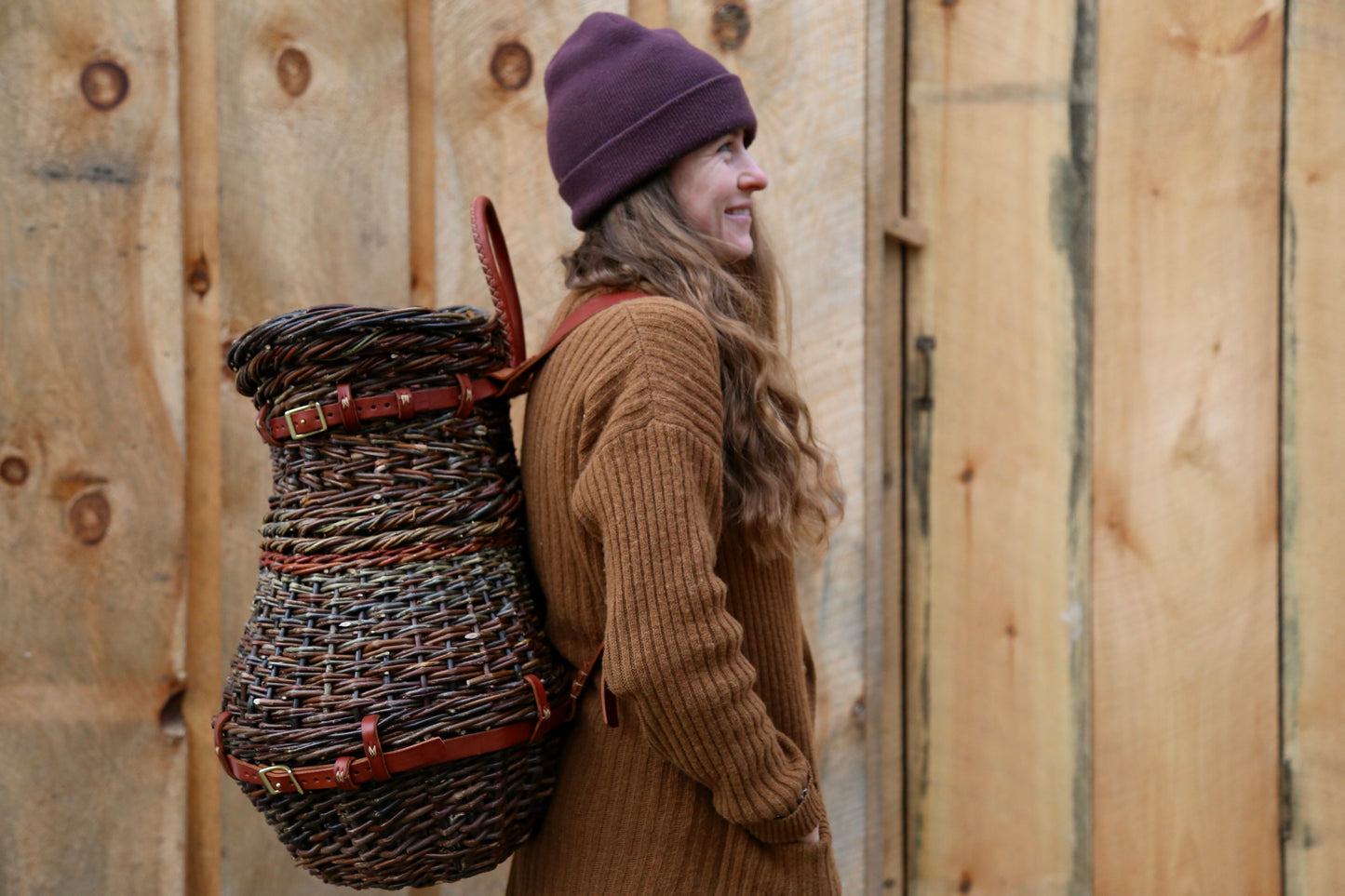
We grew willow before I ever even considered using it to weave a basket. A handful of years ago, when I spent a summer growing cut flowers in addition to our fruit, we planted decorative willow purchased from Vermont Willow Nursery. Curly red willow, fasciated willow, a few varieties of very large pussy willow, one variety that grows 10-12 feet each season and can be even used for garden stakes once dried. For a few years, the willow grew on our farm, providing beneficial habitat for birds and insects, and early food for bees, since willow is one of the first plants to flower each spring.
Only after becoming fascinated with willow basketry on Instagram did I realize how useful the willow could be from an artistic perspective. Photos of beautiful hand woven willow baskets made lovingly by people across America and around the world found their way into my explore feed. I longed to learn how to weave some myself.

Scott in the willows mid-summer

Crystal in the willows in late fall
In winter of 2019-2020, I ordered cuttings of basketry willow from Dunbar Gardens. Willow grows like a weed; just firm a stick in the ground and unless you have very bad luck, a dry spring with no irrigation, too much shade, or intense weed pressure, like magic, it will grow 3-4 feet tall by the end of the season.
We mulched the willow with our usual heavy wood chip mulch, kept it weeded and watered, and watched it flourish. For us, the willow was left alone by most pests, except for Japanese Beetles and Potato Leafhoppers, which didn't do too much damage.
Willow is harvested in the winter, when the stalks are a vibrant rainbow of colors and the leaves are gone. I quickly learned that much of basketry is sorting willow. Sorting rods by length, thickness, color, variety/species, etc. The principle of sorting is crucial to weaving a good basket. You must start with sorted willow, then carefully choose willow of the correct length and diameter for the base, stakes, and weavers.

Our first small crop was harvested in late winter/early spring of 2021, and sorted, bundled, and dried. It was not until December 2021 that I had time to explore actually weaving with the willow. When I did, I was instantly hooked! Taking advantage of a warm spell in December (30 and 40 degree days), I filled a metal stock tank with water, put in a stock tank de-icer to help keep the water warm (spoiler alert: it didn't make the water warm at all but it did keep it from freezing over), and put my entire year's crop into the tank to soak. In ideal conditions of water around 80 degrees F, willow should take a few days to a week, or even 2 at max for really fat rods, to soak. Because the water was so cold, my willow was in the tank for an entire month. I checked on the bundles every day, bending the rods near the base to see if they would bend to a 90 degree angle without breaking. When they would, I took the bundle out of the tank to mellow before weaving.
I was able to weave three baskets with our first crop of willow, and Scott tried his hand at weaving by making a really cool tray using the fattest rods that I couldn't use for my baskets.
We are both very excited about the prospect of growing willow, and plan to plant a 1/4 acre plot this spring. After doing much internet research, I realized how difficult it is to actually purchase dried willow for weaving, and many people don't have the space to grow it themselves. Our plan is to try our hand at growing basketry willow to sell dried on our online shop, so willow weavers across the country can easily purchase it and have it shipped to them. We purchased about 25 new varieties of willow to plant this spring, and have taken hundreds of cuttings from our own willow patch too. All in all, we plan on planting 9, 200' rows at 4 foot centers, with plants 1 foot apart in each row. This means we will be planting 1,800 willow cuttings this spring. We can't wait!
Here are a few photos of my first baskets. I loved every second of weaving them, even though I was left with sore shoulders and blistered fingers. I can't wait to learn more and grow more willow! We are currently working on harvesting the 2021 crop (the willow's second crop), and we can't wait to get it dried so we can both weave more baskets.
Here is my first basket. I was aiming for a small garbage can, but it's so pretty I don't know if I want to use it for its intended purpose!

This pack basket was the second basket I wove. Scott suggested trying to weave a backpack, and I just went for it.



Here is an asymmetrical willow basket. This is the third basket I wove. With each basket, I learned new weaves/techniques.

Stay tuned for more! Be sure to follow us on Instagram @underthetreefarms for updates on our willow patch and weaving adventures.
~Crystal
